Natural Tick Repellents for Dogs
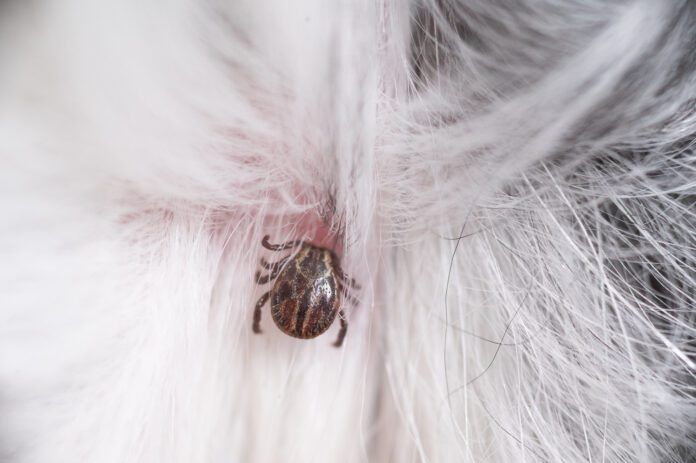
Vet-Recommended Dog Chews

Dog chews have real benefits. They can help with dental health, help alleviate anxiety, and provide mental stimulation. And, most dogs just love to chew.
“Chewing is your canine friend’s equivalent to scrolling through social media posts when you want to kill a few extra minutes,” according to American Animal Hospital Association (AAHA). “Bored dogs are often naughty—barking excessively, digging, and destroying your belongings—so encouraging appropriate chewing is important.”
Of course, as with any consumer product, navigating the wide array of options can be overwhelming. This article will help you make informed choices, ensuring your dog’s safety and well-being, including dental chews, anxiety-reducing chews, and allergy chews. (Also, check out Whole Dog Journal’s test of seven popular chews.)
Whole Dog Journal is reader-supported. If you purchase through links on our site we may earn a commission. Whole Dog Journal does not accept money for its food and product reviews.
Vet-Recommended Dog Dental Chews
Veterinary professionals and organizations like the American Veterinary Medical Association (AVMA) and the AAHA recommended products accepted by the Veterinary Oral Health Council (VOHC) when choosing a dog dental chew.
Dental disease is one of the most common health problems in dogs. It can lead to pain, infection, and even health issues affecting the heart, kidneys, and liver. While daily tooth brushing is most effective for at-home care, supplementary dental chews, which can help scrape away plaque and reduce tartar buildup are a valuable addition to your dog’s oral hygiene routine.
The VOHC seal is an independent indicator that a product has undergone scientific testing and is proven to reduce plaque and/or tartar. In short, a VOHC seal on a dental chew means a team of experts verified that the product is safe and effective.
Popular VOHC-accepted options include:
Greenies: Greenies have multiple products and sizes.
Earned the VOHC seal for helping to control both plaque and tartar.
WHIMZEES: This brand of vegetarian dental chew is well-known for their unique shapes.
Earned the VOHC seal for effectiveness in reducing plaque and tartar.
OraVet Dental Hygiene Chews: These chews are formulated to create a barrier to help prevent bacteria from attaching to a dog’s teeth.
Earned the VOHC seal for tartar control.
C.E.T. VeggieDent Chews: Virbac offers plant-based chews.
Earned the VOHC seal for helping to control plaque and tartar.
Purina DentaLife: A popular, consumer-friendly brand daily oral care treats.
Earned the VOHC seal for helping to control tartar.
Milk-Bone Brushing Chews: Known for ridged texture designed to scrub teeth as the dog.
Earned the VOHC seal for tartar control.
Pedigree Dentastix: This brand is widely available.
Earned the VOHC seal for helping to control tartar.
The VOHC’s official list is extensive and includes many product types, flavors, and sizes.
In addition to VOHC seal of acceptance look for ingredients like chlorophyll, enzymes, and zinc gluconate, which can further aid in oral health. While dental chews are beneficial, they are not a substitute for regular professional dental cleanings by your veterinarian.
For other types of chews, veterinarians recommend a nuanced approach to other chew types:
Dog Calming Chews: Easing Anxiety Naturally
If your dog suffers anxiety due to separation, thunderstorms, travel, or other triggers, calming chews can offer a solution. Many chews use natural ingredients like L-tryptophan, chamomile, passionflower, or hemp-derived compounds (such as CBD, where legal), even, according to some research reports, melatonin.
These ingredients work to promote relaxation. When selecting a calming chew, look for products with third-party testing to ensure purity and accurate dosing. Your vet can advise on the appropriate type and dosage for your dog’s specific anxiety level.
According to a Cornell DogWatch article, 83% of dogs given CBD chews prior to a stressful event showed a decrease in stress or anxiety-related behaviors. However, Cornell DogWatch warns that more research with different CBD products and dosages is needed. For that reason, it’s especially important to consult with your veterinarian about CBD chews.
No-Hide Chews: A Safer Alternative to Rawhide
Rawhide chews have been proven to bring significant risks, including choking, digestive upset, and intestinal blockages. “Rawhide is difficult to digest due to it being a byproduct of leather, making it difficult for a dog’s digestive system to break down. This creates a risk of obstruction in the esophagus or intestines if a dog swallows a large piece,” according to the Preventivevet.
A Cornell report concurs, adding that in addition to rawhide, “Chewing hard objects can result in either gradually wearing or fracturing of teeth. Use caution when offering your dog any hard objects including bones, antlers, hooves, and hard manufactured toys.” As a rule of thumb, if you can bend or flex the object, it is less likely to fracture a tooth. Additionally, if something is too hard for you to chew, then you should not allow your pet to chew it.
No-hide chews are a safer alternative and are typically made from digestible proteins like chicken, beef, or pork. They are designed to break down more easily in a dog’s digestive system, reducing the risk of obstruction.
Dog Allergy Chews: Soothing Itchy Skin and More
Symptoms of allergies in dogs include itchy skin, paw licking, ear infections, or digestive issues. Allergy chews often contain ingredients aimed at supporting skin health and immune function. Common ingredients include omega-3 fatty acids, quercetin (a natural antihistamine), spirulina, and probiotics. These ingredients work to reduce inflammation, strengthen the skin barrier, and regulate the immune response. If your dog is experiencing allergy symptoms, your first step is to contact your veterinarian to diagnose and treat specific allergens and develop a plan, which may include chews.
Vet-Recommended Options for Aggressive Chewers
Some dogs make short work out of chews that may be marketed as long-lasting. Aggressive chewers require durable, safe chews that can withstand their powerful jaws without splintering or posing a choking hazard. Also, long-lasting chews provide mental stimulation and keep energetic dogs occupied. For these dogs, vet-recommended options often include:
- Rubber toys: Brands like Kong offer durable rubber toys that can be stuffed with treats, providing a long-lasting challenge without the risk of splintering.
- Hard cheese chews: Made from yak and cow milk, these chews are hard and long-lasting, gradually softening as your dog chews them.
- Nylon or polymer chews: Tough, nontoxic synthetic chews are designed to withstand aggressive chewing and are specifically designed for this purpose.
Something to Chew On
Choosing the right chew for your dog involves careful consideration of your dog’s individual needs, chewing style, age, and any health concerns. One dog might take a long time to chew through the same chew that another dog gnaws slowly. Never leave your dog unattended when he’s chewing on anything; there is always a risk of choking.
Overall, by prioritizing general vet-recommended products, talking with your own veterinarian, and doing your research on the benefits and risks of different types of chews, you can provide your canine companion with safe, enjoyable, and beneficial chewing experiences.
Coccidia in Dogs

Coccidia are common intestinal parasites that impact dogs, particularly puppies and immunocompromised animals. While this may sound alarming, coccidiosis in dogs, the disease caused by the coccidia parasite, is treatable and preventable with proper hygiene and prompt veterinary care.
What Are Coccidia in Dogs?
Coccidia are microscopic, single-celled organisms known as protozoa. They infect the intestinal lining of dogs and reproduce within the cells of the intestinal tract. Unlike some parasites, coccidia cannot be seen with the naked eye and require microscopic examination of a fecal sample for proper diagnosis.
How Did My Dog Get Coccidia?
Dogs, especially puppies, typically become infected with coccidia by ingesting oocysts, the parasite’s hardy eggs, which are shed in the feces of an infected animal. These oocytes can survive in the environment for extended periods of time, particularly in warm, moist conditions like kennels, dog parks, or the soil in yards.
A dog may ingest the oocytes by licking contaminated surfaces, eating contaminated food or soil, or having contact with infected feces. Once ingested, the oocysts go under changes that allow the organism to invade the cells of the dog’s intestinal lining, leading to inflammation and gastrointestinal upset.
Coccidiosis is most common in puppies under 6 months of age because their immune systems are still developing and are less able to fight off infection. Stress, such as weaning or relocation, can further weaken a puppy’s immune system and make them even more vulnerable to infection.
Adult dogs can also become infected, although they may not show signs of infection and can act as asymptomatic carriers, shedding and spreading the parasite to more vulnerable animals.
What Does Coccidia Cause in Dogs?
The symptoms of coccidiosis can vary based upon the dog’s age, immune status, and the severity of infection. In mild cases, there may be no visible symptoms. More commonly, infected dogs may experience:
- Watery or diarrhea, with mucous and/or blood
- Dehydration
- Vomiting
- Weight loss
- Lethargy
- Pot-bellied appearance
Left untreated, especially in puppies or dogs with underlying health issues, coccidiosis can lead to severe dehydration which can be life-threatening if left untreated.
Diagnosis is made by a veterinarian through a fecal flotation test, where the stool sample is examined under a microscope for the presence of oocysts.
Treatment for Coccidia in Dogs
Treatment involves prescription antiparasitic medications that help stop the parasite from reproducing. Treatment may last five to 14 days, depending on the severity of infection. In severe cases, supportive care such as fluids, electrolytes, and a diet for sensitive stomachs may be needed to help stabilize the dog.
If your dog tests positive for coccidia, sanitation is key. Avoid visiting high-traffic areas, like dog parks and kennels, with puppies or young dogs. Remove any feces from your yard and bag it for disposal. Wash toys and bedding and keep the areas your dog frequents sanitized. While there is no vaccine for coccidia, good sanitation, stress reduction, and early intervention can go a long way in controlling its spread.
Preventing Coccidia Infections in Dogs
Coccidia spreads easily though contaminated feces and the environment, but with early detection and appropriate treatment, most dogs recover quickly. Responsible pet care, including routine vet visits, fecal screenings, and maintaining sanitary conditions can help prevent infection and keep your dog happy and healthy.
What Can I Wash My Dog With (That Isn’t Dog Shampoo)?

Some dogs have a knack for rolling in disgusting, decaying, and dreaded guck. It usually happens when the pet supply shops and the groomer are closed and that bottle of dog shampoo you had in your cabinet is nearly empty.
You scratch your head and think, “What can I wash my dog with that isn’t dog shampoo?”
You start frantically rummaging through your house, looking for anything that might be a dog shampoo alternative, mumbling to yourself, “Hmmm, is Dawn dish soap safe for dogs? Is baby shampoo safe for dogs? Wait, can you use human shampoo on dogs?”
We surveyed the experts, and while you shouldn’t make a habit of it, you can use some of these products to wash your dog in case of a malodorous emergency. However, there are some caveats.
Here’s why: Human shampoo is formulated for humans. Dog shampoo is made for dogs. When you use a non-dog shampoo on your pooch, it could cause irritation, dandruff, or even skin ulcers that need medical attention.
“Dog skin is not as thick as human skin,” says veterinarian Mitzi Clark, an assistant clinical professor of dermatology at Cornell University College of Veterinary Medicine. “The outer layer of the skin is thinner in dogs, so it’s much easier to strip that outer layer of a dog’s skin and dry it out.”
And anything you use on a dog’s skin seeps into their system faster than it would in a human.
“It’s easier to penetrate the outer layer of a dog’s skin, the epidermis, and get to the dermis, which is the layer of skin that has the blood vessels where the ingredients could be absorbed into their system,” Dr. Clark says. “Dogs, in general, due to having thinner skin, just don’t have as much protection against the world as other species, including humans. It’s one of the reasons they probably have more issues with bacterial infections, allergies, and other diseases that predispose their skin to those conditions.”
So knowing dogs generally have more sensitive skin than humans, how should you answer the question: What can I wash my dog with that’s not dog shampoo? Here’s what you need to know.
Is Dawn Dish Soap Safe for Dogs?
Dawn dish soap is well known in animal rescue circles for working miracles. Rescuers use it to de-grease wild animals soaked in oil after spills and help dogs and cats covered in fleas and ticks. It’s also the main ingredient in a DIY skunk smell-removing shampoo.
“It’s a really potent degreaser, that’s why we use it to degrease our dishes,” Dr. Clark says. “It’s very stripping to a dog’s outer layer of skin, so the biggest issue is that it can be drying.”
But if you have a doggone disaster, Dawn dish soap is typically safe for dogs.
“It wouldn’t be something we would recommend doing weekly, or on an ongoing basis, or for a long time,” Dr. Clark says. “But if you have a situation where, ‘My dog just rolled on a dead animal,’ it’s something you could reach for in a pinch, and most animals are going to tolerate it fine.”
Avoid getting dish soap in your dog’s mouth, eyes, and ears. Their ear canals are more sensitive than their skin.
“Dilute the dish soap in some water first, so you can get more mileage out of it, rather than just slapping it on one section of the dog,” says extension veterinarian Aly Cohen from the Cornell University College of Veterinary Medicine. “Be sure to really, really rinse your dog thoroughly so you don’t have any leftover residue in the fur or the skin that could sit there and cause some irritation.”
Can You Use Human Shampoo on Dogs?
If you have a favorite shampoo that makes your hair glossy, shiny, and silky, that’s likely because it’s designed for humans. It might not do the same for your dog. Before you consider using human shampoo on dogs, check the ingredients.
“Some of the more natural products that contain essential oils can be a problem,” Dr. Clark says. “We’ve seen reactions to tea tree oil, citrus oil, and citronella oil. You have to be careful using shampoos with essential oils on dogs. Some of them can be quite harmful; those are things I would steer away from.”
Our experts also recommend steering clear of using human shampoos that contain parabens, phthalates, and formaldehyde on dogs.
“I would try to avoid anything that’s heavily fragranced with perfumes or extra scents,” Dr. Cohen says. “Those can be a little harsh, irritating, or sometimes even toxic, if they happen to ingest any of it.”
Can You Use Baby Shampoo on Dogs?
Is baby shampoo safe for dogs? You may think, “If it’s gentle enough to use on a baby, it must be OK for dogs, right?” Not necessarily.
“Baby shampoo will generally be a little bit milder than regular human shampoo,” Dr. Cohen says. “But they’re generally still formulated for human skin.”
Make sure the baby shampoo doesn’t contain any of the ingredients that can be harmful to dogs, which are sometimes found in human shampoos.
Before you dive into your cabinet looking for dog shampoo alternatives, remember that if your dog is covered in something that’s not oily, greasy, or smelly, you can just use water to rinse them off; no shampoo is needed. Unless dogs have a medical condition and need special shampoo and baths, they don’t typically need to be bathed regularly.
While not ideal, turning to dish soap, human shampoo, or baby shampoo when you have a putrid predicament may be the stink-reducing rescue potion you need; with the proper precautions, these products could work as dog shampoo substitutes. You may also be able to make your own dog shampoo from ingredients you have on hand.
Keep in mind that there’s no guarantee your dog won’t have a problem or reaction to any of these alternatives, even if you use shampoo made for dogs. Every dog and product is different.
“After using a new shampoo, keep an eye on them,” Dr. Clark says. “If they’re a little bit flaky, but the dog doesn’t care, fine. If they get red and irritated, they may need veterinary care. I think probably the most important takeaway is that even though dogs are family members, pet parents need to understand that their skin is different. Not everything safe for humans is necessarily safe for dogs.”
Understanding Dog Temperament

Join Whole Dog Journal
Already a member?
Click Here to Sign In | Forgot your password? | Activate Web AccessParaphimosis in Dogs

Normally, a dog’s penis is safely tucked inside the preputial sheath of haired skin that covers it. If a dog cannot retract his erect penis into the sheath, it is called paraphimosis. You may hear this colloquially referred as to “red rocket out,” or “lipstick showing,” or “red rocket dog.” No matter what you call it, it is not a normal state.
A dog’s penis is covered with moist, sensitive tissue. If it dries out, tissues may die. The tissues are not strong and may easily get cut or torn. The penis will normally stay outside the sheath and visible after a breeding or semen collection but should return to its normal location in 30 minutes or less. Some dogs may take longer but certainly not more than an hour.
While you don’t need to make a dash to the vet clinic with sirens blaring, this condition needs to a veterinary evaluation, especially if it continues for more than an hour or two.
Some breeds appear to have a predisposition to paraphimosis, including Bouvier des Flandres, German Shepherd Dogs, Golden Retrievers, and Labrador Retrievers.
How to Fix Paraphimosis in Dogs at Home
If you catch the problem early, applying a cold compress can help to shrink an enlarged penis. Fans of the TV show “All Creatures Great and Small” may remember that you can try sprinkling sugar on the swollen penis. The osmotic pull of the sugar helps to reduce the swelling, allowing the penis to be retracted. These simple steps may work for a mild case, caught early on with no complicating factors.
However, despite these attempts, the penis may become or stay swollen, which will exacerbate the problem as the penis may no longer fit back into the sheath. In addition, as the tissues dry, there is more friction created when your dog tries to retract his penis, so he may stop trying. It hurts! The dry tissue may also pull the haired skin around the orifice in with it, again causing a stop to retraction.
You might notice your dog licking his sheath area obsessively, walking with a hunched back, whimpering, or having trouble urinating. Left outside, the tissues will dry and become friable. You may see the penis change from a deep pink color to blue or black as the tissues become oxygen deprived and die. At this point, it is a dash to the emergency clinic situation!
What Causes Paraphimosis in Dogs
Why would your dog extrude his penis and leave it? There are numerous reasons. A young male who is sexually excited may not “think” to retract his erection when it settles. Again, after an hour, everything should be normal (preferably within 30 minutes). If not, call your veterinarian.
If the preputial orifice is tight, your dog may find it uncomfortable to pull his penis back in. He pushed it out in the heat of the moment, but now he has calmed down and finds it uncomfortable. This could require minor surgery to open the end of the sheath for a permanent solution.
The big concerns are anything that might constrict blood flow to the penis. A foreign body caught in the sheath could block the return of the penis. Plant material, especially in the fall and during a dry spell, is not uncommon. An unusual situation would involve any skin growth or small tumor on the penis, but it happens. My sister’s German Shepherd Dog had a small wartlike growth on her dog’s penis, which prevented it from returning all the way into the sheath. Surgical removal was required.
Any trauma to the penis, especially if it occurs while it is extended, can result in swelling that prevents return to the sheath. Extensive trauma may require surgery. Keeping the extruded penis lubricated may prevent more damage while it heals with eventual ability to retract it fully.
Any infection in the sheath could lead to the penis being swollen and sore, with your dog resisting retraction. Being outside in cold temperatures with a penis exposed to the air can lead to frostbite damage. Anything beyond mild damage will require surgical intervention to remove the dead tissue.
Neurologic disease may interfere with movement of the penis back into the sheath, but generally there are other neurologic signs present such as gait abnormalities.
One of the most common problems is hair wrapped around the shaft of the penis. This can occur with a dog’s own hair from around the sheath or hair from the female dog during a breeding. The hair forms a tight band around the penis and blocks blood and lymphatic flow. Tissues may become necrotic from the lack of oxygen and nutrients.
Any necrotic tissue will require surgical removal, which can lead to another complication if your dog develops scar tissue that makes it hard for him to retract his penis. The worst-case scenario is a penile amputation.
If your dog requires veterinary assistance to get the penis back into the sheath, you will need to be very observant for any recurrence. Your dog should be prevented from licking that area for at least a week. Your veterinarian may put in a “purse string suture” to hold the penis in place.
Can You Prevent Paraphimosis?
If your dog is used for breeding or has a semen collection, always keep track that the penis returns to the sheath, again, ideally in 30 minutes. If it goes over an hour, contact your veterinarian. If your dog feels he is “super stud,” keep him away from bitches in heat unless being bred to discourage unnecessary erections. Consider neutering if he repeatedly gets paraphimosis.
Trim the hair around the end of his sheath to prevent any being pulled in when he retracts his penis. Wrap the tails of long hair bitches he is being bred to. You may want to wet down long hair around the vagina and/or apply a sterile lubricant to minimize chances of hair getting caught on his penis.
Furunculosis in Dogs
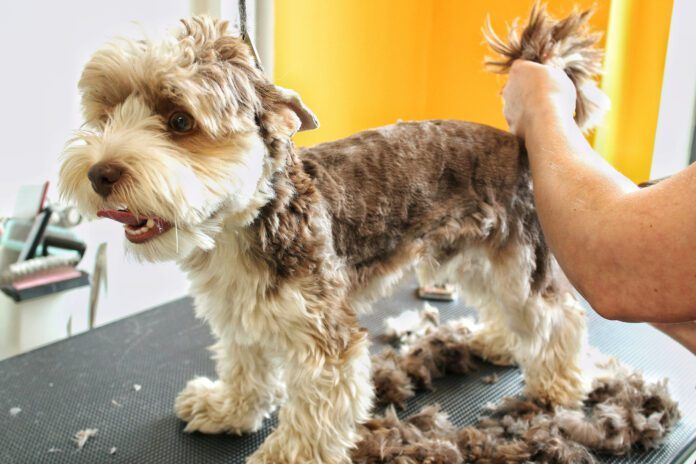
The word furunculosis sounds ugly and gross, which perfectly describes this skin condition, which grows under your dog’s fur.
Furunculosis appears as red bumps under the skin. They are inflamed, generally painful, and may have a purulent or puslike exudate. You may hear a furunculosis bump called a dog boil. While furunculosis is a deep-seated bacterial infection that usually starts in hair follicles, it is not folliculitis. Folliculitis is a superficial bacterial infection.
Furunculosis can occur in different areas and often involves Pseudomonas species of bacteria. Pseudomonas species are notoriously difficult to eradicate and nasty pathogens.
Likely Spots for Furunculosis in Dogs
The four usual areas where you may see furunculosis are:
- Muzzle/face
- Interdigital (between toes)
- Anal
- Body (less commonly, often post grooming)
These all look similar but have varying degrees of difficulty to clear.
Bumps on Dog’s Face
The muzzle/face cases tend to be in young dogs. They start out looking like classic puppy chin acne. Some pimples, a little redness, and your pup may rub his face a bit. Unfortunately, this then becomes a deeper infection. Inflammation, purulent discharge, and pain are common. Demodex must be ruled out as a possible cause.
For mild cases caught early, topical therapy may work. That means cleaning the area well, then drying it thoroughly as moisture simply encourages the infection. A topical antibiotic cream may work, though many dogs will require an oral antibiotic. Painful pups will benefit from an anti-inflammatory.
If you feel bumps on your dog’s body, they may be something as mild as hives. Most cases of hives are mild, come up quickly, and are smooth and round. They tend to respond to a dose of antihistamine or will resolve on their own over a matter of hours.
Inflamed Toes on Dog
Interdigital furunculosis can start as allergies affecting the area between the toes. Mild yeast infections provide a moist, inflamed setting for bacteria to flourish. Some cases start with foreign bodies, like plant material such as foxtails, penetrating the skin and creating a sore. Any irritant to the foot can start the cycle of inflammation that leads to infection.
Interdigital cysts and autoimmune conditions are behind some cases of foot furunculosis. This problem is more common in dogs with short hair (think Weimaraners), but Labrador Retrievers and Bulldogs seem to get this problem more than other breeds as well. Hypothyroidism and Cushing’s disease may be contributing factors as well due to their influence on the immune system. Just one area may be affected or the whole paw.
You may notice your dog limping, holding up a paw, or licking excessively at his feet. Some owners can pick up an obnoxious odor. This can be painful, and your dog may resist you handling his paws.
Warm water soaks with Epsom salts help with healing and provide some comfort. If your dog resists keeping a paw in a small bucket, put a couple inches of warm water in the bathtub with some Epsom salts. Chlorhexidine can be used in soaks as well.
Post soak, thoroughly dry the paws. Any moisture simply makes it a good place for yeast and bacteria to thrive. I then apply foot powder. Most foot powders are antibacterial, antifungal, anti-inflammatory, reduce itching, and taste bad. Ointments and creams often simply encourage more licking, requiring the use of a cone to stop the dog from licking.
Some foot infections will require oral antibiotics or antifungal medications. For stubborn cases, your veterinarian may do a culture and sensitivity. Your dog may also need bloodwork for autoimmune diseases and a thorough exam for any foreign bodies. Pain medications may be necessary to keep your dog comfortable. Laser surgery can be used for resistant cases.
Perianal Fistulas
The worst cases of furunculosis are perianal fistulas. While up to 80% of cases are seen in German Shepherd Dogs, these fistulas can occur in other dogs as well. The classic case is a middle-age, intact male dog. Originally, the blame was put on the thick tail of shepherds, which tends to be carried down, so the anal area does not air out and dry. Now, it is felt that this is more of an immune problem.
Owners may notice their dog having trouble defecating, straining, some bloody discharge on stools, even whining in pain when eliminating. There may be discharge noted on bedding and a foul odor from the rear of the dog. Initially dogs may “scoot” their rear, like with an anal-gland problem. Some dogs will have diarrhea or constipation, and all dogs will lick the area excessively.
Sedation may be required for a thorough exam. A rectal will be necessary, partly to see if the anal glands are involved.
This can be a very frustrating problem to treat. Medical therapy is tried first. An oral immune suppressant such as cyclosporine is often the first step, along with antibiotics for the bacterial infection that is virtually always present. Your dog may end up on medications long term, perhaps with brief periods of remission. Recurrence can be up to 50%, if you get it cleared at all.
If medical therapy does not work, cryosurgery or laser surgery can be attempted. Some veterinarians feel tail amputation may help to aerate the area.
Many cases seem to be associated with inflammatory bowel disease so dietary changes may help.
Post-Grooming Furunculosis
Furunculosis that shows up post grooming tends to be on the back and may spread to the sides of your dog. You will feel raised areas that are often painful and crusty from inflammatory and purulent exudates. This will happen within days of grooming, usually after clipping. While dirty tools are a possibility, most groomers practice excellent hygiene. Your dog may have sensitive skin, so he reacts to the shampoo or conditioner, or he may have had a skin problem brewing which the grooming just accentuated.
These cases are painful and require a veterinary visit. A culture and sensitivity may be recommended right off the bat for bad cases. Antibiotics and pain medications are usually dispensed.
Preventing Furunculosis in Your Dog
Avoiding furunculosis in your dog partly comes down to good genetics. A dog with a good immune system will often throw off these infections before they get out of hand. It behooves you to keep your dog in the best possible shape, doing all recommended preventive care, providing good nutrition, and being observant so you can catch any problems early on.
The 5 Best Dog Packs for Hiking

Hiking with your dog is a fabulous way to spend time together and enjoy nature. It’s even more fun if you don’t have to carry a bunch of extra dog gear every time you head out on an adventure with your furry friend.
The best dog packs for hiking allow your pup to carry their own poop bags, water bottles, and even dog camping gear for overnight backpacking trips. But not all dog backpacks are created equally. Read on for how we tested 5 popular dog packs for hiking, and important things to consider before purchasing one.
If your dog has never worn a dog pack before, you’ll need to ease them into using one. If your dog is accustomed to wearing a harness already, have them wear an empty dog backpack on a short daily walk. You can slowly add weight to the pack in small increments and build up the amount of time your dog is wearing the pack.
If your dog isn’t used to a harness, start by getting them accustomed to putting the dog backpack on and taking it off, rewarding each time.
Note that your dog should never carry more than 25% of their body weight in a dog backpack, and dogs who aren’t well-conditioned or used to carrying that much weight should carry even less (roughly 10-15% of their body weight).
Traits We Want in a Dog Pack for Hiking
Ease of use: A dog backpack should be simple to put on, take off, and adjust. We put each of the backpacks on this list on multiple dogs and adjusted them to find the perfect fit.
Fit and adjustability: The fit of a dog backpack is important for your furry friend’s comfort and safety. A good dog backpack (similar to a dog harness) won’t impede your dog’s movement and should allow full front extension while your dog is hiking or running. It should also allow some clearance near your dog’s armpit. If the dog backpack rides up into your pup’s armpit, it could cause discomfort and chafing.
Having multiple adjustment points is paramount for finding a proper fit. All dogs are shaped a bit differently, so the more custom the fit, the more comfortable your dog will be in their hiking backpack.
Size range and capacity: We evaluated the available sizes of each dog backpack, giving extra points to those that offered a wider range of size options. We also evaluated the capacities/volumes of each pack, noting when the capacity changed with the size, and considering which sizes were most appropriate for day hikes, backpacking trips, or trail runs.
Durability: We used each of the backpacks on multiple hikes and checked how they held up to our active tester dogs.
Extra details: We noted the backpacks on this list that had extra dog friendly features like well-placed D-rings for leashes, removable dog saddle bags, reflective detailing, compression straps, and more.
Whole Dog Journal is reader-supported. If you purchase through links on our site we may earn a commission. Whole Dog Journal does not accept money for its food and product reviews.
The Best Dog Backpacks for Hiking
| Whole Dog Journal Rating | Product and Maker | Price | Sizes | Capacity (in order by size) | Notes |
|---|---|---|---|---|---|
    | Non-stop Dogwear Trail Quest Dog Backpack | $140 | XS, S, M, L, XL | 2L, 4L, 16L, 22L, 36L | This pack was truly created with dogs in mind. A highly ergonomic fit gives your dog amazing range of motion and is highly adjustable to fit a range of breeds. It also includes a handy compression system to make it easier for your best buddy to carry their gear. |
   | Ruffwear Approach Dog Backpack | $100 | XS, S, M, L/XL | 5L, 10L, 13L, 21L | A close second to the Trail Quest Backpack, the Ruffwear Approach is a well-loved option for overnight backpacking trips. It’s sturdy, has a thoughtful storage design, and offers just enough space for your dog to carry the essentials. |
   | Mountainsmith K-9 Dog Pack | $50 | S, M, L | 6L, 10L, 18L | This budget-friendly dog backpack is incredibly sturdy, breathable, and has a similar volume to the Ruffwear Approach Backpack. However, the fit wasn’t the best on our tester dogs. |
    | Non-Stop Dogwear Trail Light Dog Backpack | $130 | XS, S, M, L, XL | 1L, 2L, 3L, 6L, 12L | If you and your dog go out on long trail runs or day hikes, the Trail Light dog backpack offers extra storage in a non-restrictive format. It’s water resistant, allows your dog full range of motion, and is breathable for extra airflow during intense exercise. |
   | Ruffwear Palisade Dog Backpack | $150 | S, M, L/XL | 12.5L, 17.5L, 24L | This large-volume dog backpack is ideal if you plan on spending multiple nights out in nature with your dog. The saddlebags on this pack are removable, so it can be used as a harness or a backpack. |
Best Dog Backpack for Hiking: Non-stop Dogwear Trail Quest Dog Backpack

Non-stop Dogwear truly designs products with dog comfort, safety, and performance in mind. Of the options on this list, the two Non-stop dog packs offered the best fit on a variety of different dogs and also had the biggest adjustability ranges. Offering so much adjustability means that you get a more custom fit on your dog, and the packs can fit more dog breeds/sizes than other options.
The Non-stop Dogwear Trail Quest Dog Backpack has 10 different adjustment points for a truly personalized fit, with adjustment points on the outside and inside of the pack. True to Non-stop Dogwear’s harnesses (which I love and use on my own dogs), this pack also offers lots of armpit clearance to reduce the risk of chafing and offer better range of motion. Even on long bodied and deep chested dogs, this pack fit was comfortable and safe.
The Trail Quest Dog Backpack also features handy compression straps, which help keep your dog’s gear close to their body and reduce movement of the pack’s contents. The Y-shaped harness section is also padded all the way around, to distribute pulling force if your dog is a light to moderate puller, and to reduce the risk of pressure points during wear.
This pack is plenty big enough for overnight or even two-night backpacking trips, and the capacity scales nicely with the sizing, so you’re not at risk of overloading small dogs.
Runner Up Best Dog Backpack: Ruffwear Approach Dog Backpack
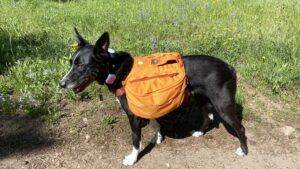
Though the dog-forward design of the Non-stop Dogwear Trail Quest pack won our testing, the Ruffwear Approach Dog Backpack is still worth an honorable mention. All sizes offer ideal capacity for single night backpacking trips and don’t typically risk overloading your dog with too much weight like larger packs sometimes do.
This pack comes with 5 adjustment points and an anti-flop system that secures the saddle bags to the harness to reduce flopping and movement while your dog hikes. The biggest perk of this pack though, is the multi-tiered pocket system.
Just like humans should pack the heaviest items in a backpack closest to their bodies for ease of carrying, the Approach pack features two deep pockets closest to your dog’s body to carry water and other heavy items. The multiple different pockets allow you to shuffle your dog’s gear as needed to balance out weight if you notice one side is heavier than the other.
The Non-stop Dogwear Trail Quest has better armpit clearance than the Approach, but the Approach pack would be a good fit for dogs/breeds who are more square in shape or who don’t have deep chests.
Best Budget Dog Backpack: Mountainsmith K-9 Dog Pack

The Mountainsmith K-9 Dog Pack is half the price (or less) of the other dog backpacks on this list. At $50, it’s a budget-friendly—yet sturdy—pick for a dog pack for hiking.
The overall construction of this bag is very durable and will stand up to regular use, even by big dogs who are hard on their gear. The harness section of the backpack is well-padded and is breathable with perforated foam and mesh construction.
The saddle bag design doesn’t flop much when dogs walk, since the pocket “pannier” compartments are attached strategically to the body of the pack. The volume of each size pack is most comparable to the sizes/volume of the Ruffwear Approach pack.
This pack had a few downsides. Firstly, the fit wasn’t the greatest on our tester dogs. It tended to ride up in the armpits, despite the decent number of adjustment points. It would be more suitable for dogs with a more square shape, rather than long-backed or deep-chested breeds. Secondly, I wish the D-ring leash attachment was at the rear of the pack rather than the front. As-is, it puts an awkward amount of pressure on the dog’s front if they pull at all.
Best Dog Backpack for Trail Running and Day Hikes: Non-stop Dogwear Trail Light Dog Backpack

If you need a pack for day hikes or runs with your dog, the other options on this list are likely too big. The Non-stop Dogwear Trail Light Dog Backpack is a lighter weight, smaller capacity option for shorter outings.
This pack is super breathable, as the harness section is made with a padded mesh material called Hexivent to allow for extra airflow. There’s also an open mesh panel at the top of the pack to allow your dog’s core to cool efficiently while running or hiking in warmer weather.
Like the larger Trail Quest pack, the Trail Light pack offers an excellent fit that gives your dog full range of movement. There’s plenty of armpit clearance, and the Y-shaped harness doesn’t restrict your dog’s shoulders in the front.
This pack is also nicely adjustable, with 6 different adjustment points for a custom fit. In addition, it features reflective detailing, water-resistant fabric, and bungee cords on sizes M-XL for extra gear storage.
Best Dog Backpack for Longer Backpacking Trips: Ruffwear Palisades Dog Backpack

If you need more gear storage for longer backpacking trips, the Ruffwear Palisades Dog Backpack is the way to go.
The highlight of this dog pack is the removable saddle bags. You can easily pop the bags off the harness and use the harness by itself if needed. Whether your dog needs a break from carrying a heavy load or you just want to use the harness by itself around camp, this feature is super handy.
The Palisades pack has similar features to the Approach pack including deep pockets close to your dog’s body for water or other heavy items, five points of adjustability, a handle, a sturdy D-ring, a relatively breathable inner foam construction, and a “flopper stopper” system that reduces the amount of movement of the saddle bags while your dog walks.
The main downside of this pack is that it could use more armpit clearance on some breeds, and, because of the large capacity, you could risk overloading your dog with too much weight (so ensure that you weigh your dog’s pack and get them used to it slowly before a backpacking trip).
How to Wash Dog Toys
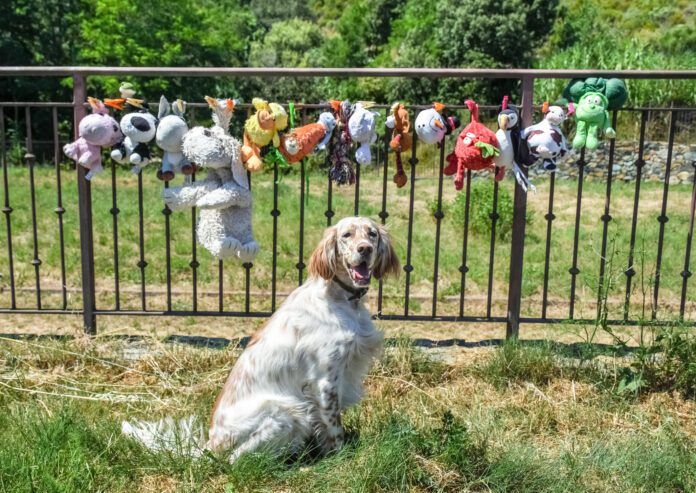
Washing your dog’s toys might seem like a minor task, but it plays a vital role in maintaining your pet’s health and hygiene. Dog toys are exposed to dirt, saliva, bacteria, and even fecal matter over time and can harbor harmful germs and allergens. Knowing how to properly clean dog toys, when to clean them, and when to discard them is key to keeping your pup safe, especially in multi-pet homes.
Dog toys come in various materials including rubber, plastic, rope, and plush. Each material requires a slightly different cleaning method. For rubber or plastic toys, washing with hot soapy water is usually effective for regular cleaning. Use dish soap and a scrub brush to get into crevices, rinse thoroughly, and allow to air dry completely. Many rubber and plastic toys are also dishwasher safe on the top rack, which is an easy way to sanitize them.
Can You Wash Dog Toys?
Plush toys and fabric-based items can often be washed in a washing machine. Use a gentle cycle with hot water and a pet-safe detergent. If your dog is sensitive to chemicals or fragrances, you can wash toys with unscented detergent or natural cleaners like white vinegar. Either air dry or tumble dry on low heat to preserve the shape and stitching.
Rope toys are a special case because they can trap moisture and grow mold or bacteria inside the fibers, it is best to soak them in boiling water with some vinegar. After cleaning, allow them to dry thoroughly, as damp toys can become a breeding ground for bacteria and mold.
How to Sanitize Dog Toys
Sanitizing toys is especially important when illness is present or suspected. Parvo, a highly contagious and often deadly virus that impacts the gastrointestinal tract of dogs, can survive on surfaces for months. Regular soap and water are not enough to eliminate it.
Bleach does kill parvo on hard, non-porous dog toys. A diluted solution of one part bleach to 30 parts water (approximately ½ cup per gallon) is recommended for sanitizing. Soak the toys for at least 10 minutes, rinsing thoroughly before putting them in the dishwasher or washing machine.
It is important to use this method only on toys that can tolerate bleach and are made of materials that will not absorb the chemical, like solid rubber or hard plastic. Removing bleach completely from plush or porous toys can be difficult and may destroy some of the synthetic materials in these toys, so toss these toys if you think they must be cleaned with bleach. Toys made from bone or wood cannot be sanitized or effectively cleaned and should be discarded.
Discard Damaged or Worn Dog Toys
Regular inspection of your dog’s toys is just as important as cleaning. Over time, toys can become damaged or worn, creating hazards like loose parts, sharp edges, or frayed strings that can be swallowed and pose choking and obstruction risks. You should discard any toys that are broken, losing stuffing or squeakers, have pieces coming off, or that cannot be effectively cleaned. If you are unsure whether a toy is still safe, it is best to err on the side of caution and replace it. A new toy will always be less expensive than an unexpected vet bill.
Washing your dog’s toys regularly is a simple but effective way to protect your pet and family from germs, illness, and injury. Clean toys not only promote better health for your dog, but also help to extend the life of the toys themselves, making it a worthwhile habit for every pet owner.
Best Affordable No-Pull Dog Harness

Everyone wants to walk their dog without being pulled down the street. Not only is it unpleasant for you, but a dog who constantly pulls on his collar—and therefore his throat—can injure himself. A good no-pull harness is a training aid that encourages the dog not to pull without causing harm, pain, or making the walk more punishing than enjoyable for your dog—and you!
Dog no-pull harnesses run from cheaply made to inexpensive quality to seriously pricey. We focused on affordable choices that work without punishing or harming the dog in any way. A good no-pull harness for a dog should discourage pulling without hurting him.
Note for usage of any no-pull harness: These harnesses are not meant to be worn continually. They are meant to be worn for outings such as walks. Continual wear of such harnesses could contribute to skeletal and skin issues.
I focused on finding what appeared to be the most affordable no-pull dog harnesses that are designed to not cause harm or pain and are widely available. I tested them all on my 45-lb. female Chow Chow, Meridiana, who has some attention deficit/hyperactivity disorder (ADHD) tendencies, despite responding well to training.
What We Want in a No-Pull Harness
An affordable no-pull dog harness should help you train your dog to stop pulling on the leash while doing him no harm. It should fit well so he can’t escape the harness, and it should be well constructed so it’s strong enough for the dog it’s designed for. With the harnesses in this test, I looked for:
- Easy fit: It shouldn’t take half of your day to figure out how to fit a harness on your dog.
- Size range: Adequate size ranges for most dogs.
- Quality of construction: Even affordably priced harnesses should not appear as if they are going to fall apart with use. They should be comfortable for the dog.
- Pricing: I targeted harnesses under $50.
- Function: A harness promoted as a no-pull harness should minimize pulling.
Whole Dog Journal is reader-supported. If you purchase through links on our site we may earn a commission. Whole Dog Journal does not accept money for its food and product reviews.
The Best No-Pull Dog Harnesses
| Whole Dog Journal Rating | Product and Maker | Price and Size | Notes |
|---|---|---|---|
    | 2 Hounds Design Freedom Harness | $44 and up Seven sizes from XS through 2XL | Includes a double attachment leash if needed. The underneath portion is velvet for comfort. It’s reasonably easy to fit on the dog and secure when fitted properly. The fit does not migrate much with usage. |
   | Petsafe 3-in-One Harness with Two-Point Control | $30 3 sizes, small, medium, and large | This harness has the most fit adjustment points, but that makes it complicated to fit. It was very secure once fitted with too many attachment points to fail at once. Has a double attachment leash as an option. Very well padded for comfort. |
   | TrueLove Adjustable No-Pull Harness | $25 and up 5 sizes from XS to XL 10 colors | Well-padded for comfort, not terribly difficult to fit but not the easiest either, reflective, with two points of attachment. |
   | JWalker No-Pull Dog Harness | $46. 5 sizes tiny to XL 10 colors | This is the only harness that is a side attachment harness. Very well made and stylish and very easy to fit and use. Can attach the leash to either side attachment. |
  | Petsafe Easy Walk Harness | $23 Petite through extra-large Nine colors | Martingale loop on front of harness where leash attaches to, easiest to fit but may be easiest to get out of, too. Fits wider-chested dogs better than narrow-chested dogs. The fit migrates the most with usage. |
Best Affordable Dog No-Pull Harness: Freedom No-Pull Harness by 2 Hounds Design
Freedom No-Pull harness by 2 Hounds Design was the easy top choice here. It was a bit complicated to fit initially, but with use, it became simpler. I sometimes fit it differently than the manufacturer’s instructions suggest. For most dogs, I will shorten the front cross strap and the T-strap all the way before putting it on the dog to determine the fit of the underneath velvet portion. For very tall dogs, I eyeball the T-strap and shorten accordingly. For very broad-chested dogs, I may leave the cross straps out a bit more. My aim is to create a V-shape in front versus the straps going straight across the chest. The clips end up being on each shoulder blade on top of the dog. This creates not only more comfort for the dog but also more control for the human. The front won’t sag as much. I don’t generally recommend using the double-ended leash. Instead, I use a regular six-foot leash on the front attachment. In the car, I use that double-ended leash on the back attachment as a car harness tether. This harness, when properly fitted, is virtually impossible to get out of. The quality of construction is fabulous. It comes in many colors and patterns and two widths.
If you want the reflective version, the fit may migrate much more with each use than with the non-reflective options. That said, this harness’s fit rarely migrates much with use, regardless of whether the dog attempts to pull while wearing it.
One complaint is that because of the positioning of the front attachment, there is a high likelihood that the leash gets repeatedly under the legs. A hack that prevents this is to attach the leash on the front then loop it through the tiny martingale on the top of the harness. I do this when I walk with a regular six-foot leash, but it’s cumbersome to do with a long line. It retains its shape with washing, which can be done in a washing machine. I do suggest line drying though.
Most Adjustable No-Pull Dog Harness: Petsafe 3-in-One Harness
The Petsafe 3-in-One harness was a pleasant surprise and our runner-up. While it was the most complicated to fit, once I got what I wanted, I was satisfied. I’d bet it would take a double-jointed dog to get out of it with the way that it fits—there are so many clasps that would have to fail. It’s well-made and cushioned. The structure ensures that you fit it securely but not tightly. It’s comfortable for the dog. I found the structure makes this well-suited for hiking as well as a car harness. The higher front attachment point makes this one less likely to have the leash get repeatedly under the legs, which I appreciate having a low to the ground dog.
Best Budget No-Pull Harness: TrueLove Adjustable No-Pull Harness
If you’re looking for the most bang for your buck, the TrueLove Adjustable No-Pull Harness is amazingly well made for the money. It was complicated to fit, but once done, it was comfortable for her. It might feel a bit heavy for coated dogs, especially in the warmer months. It prevented pulling nicely, and the leash got under her legs less than some harnesses because of the higher positioning of the front attachment.
Best No-Pull Dog Harness with Side Attachments: JWalker Harness
The JWalker harness is beautiful with vibrant colors and a satiny feel. The design is unique with the attachments being a martingale loop on either side of the front. It’s easy to fit and doesn’t migrate much with use. My only complaint about this harness is that I think the martingale loops should be smaller. This harness was the one that I could not use without having it under my dog’s legs continually. Those with taller dogs would have less of an issue with that. I like the side attachment quite a bit, and it did reduce pulling in a unique way that front attachments don’t seem to do, without causing any discomfort to the dog. This harness was invented by a positive trainer.
Also Tested: Petsafe Easy Walk Harness
The Petsafe Easy Walk harness is probably the most widely available no-pull harness, but I found the martingale loop in the front allows the harness to sag a bit too much and may obstruct normal forward movement. I found the fit can be improved by snugging up the top first and taking care to adjust the fit so that the front strap is high enough on the chest to not be a problem. In addition, I would use a connector with this harness to attach the harness to the collar as well because I was concerned that a dog might be able to slip a leg out of the harness and escape, especially a dog with a short elbow-to-shoulder ratio.
A no-pull harness is certainly the way to go if your dog is a puller because you don’t want him to escape or harm himself. I encourage training to correct pulling, and a no-pull harness is also a training tool.
Best Toothpastes for Dogs
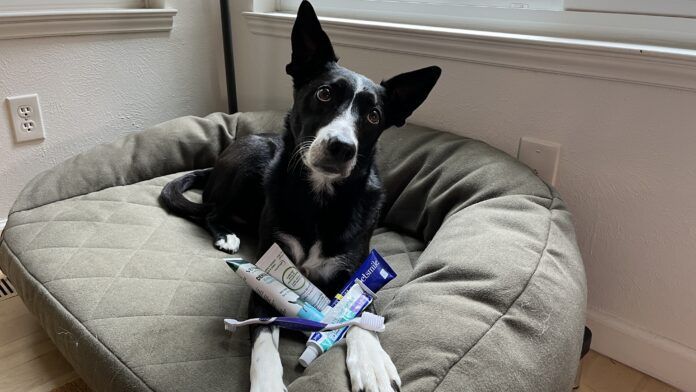
We’ve all smelled doggy breath. But that stinky odor coming from your dog’s mouth isn’t just “how dogs are” — it’s often a sign of bad oral hygiene or periodontal disease.
Just like humans, dogs’ teeth get plaque and tartar up from food if you don’t brush often enough. Brushing your dog’s teeth with a dog toothpaste and toothbrush regularly can help control build up on your pup’s teeth and keep it from getting worse.
If you have a young dog who doesn’t have much build up yet, brushing regularly with a high-quality dog toothpaste will keep those teeth pearly white, and may help reduce the risk of associated health problems.
We talked with Dr. Teresa Manucy DVM, a Florida-based virtual veterinarian for Chewy’s Connect with a Vet service, about how to pick a dog toothpaste for your pet, and all things related to dog dental health.
How Often Should You Brush Your Dog’s Teeth?
“It’s ideal to brush a dog’s teeth daily since the plaque is easy to brush off before it calcifies within 48-72 hours,” says Mauncy. She recommends focusing on the upper and outer surfaces of your dog’s teeth, since the majority of food build up occurs near their lips and cheeks.
“Brushing at least two to three times per week will help prevent the development of serious dental disease,” she says.
If you don’t brush your pup’s teeth regularly, Mauncy says that your dog may have an increased risk of developing tooth and gum issues, like gingivitis, periodontal disease, tooth loss, and possible tooth fracture. Severe periodontal disease can also lead to bone loss, infection, and even organ damage.
Traits We Want in a Dog Toothpaste
“When purchasing a dog toothpaste, pet parents should consider ones that contain ingredients that are safe for dogs to swallow,” says Mauncy. Human toothpaste should never be used on dogs, since the ingredients are not safe for ingestion.
“Dogs do not spit their toothpaste out and ingestion is likely,” she says. “Human toothpaste often contains detergents, fluoride or xylitol which are toxic if swallowed.”
Mauncy also recommends finding a toothpaste with a flavoring that your dog enjoys. From a training perspective, your pup will be happier to have their teeth brushed if they enjoy the flavor of the toothpaste, since it’ll act as a treat during the process.
In terms of ingredients, dog toothpastes should contain an abrasive ingredient like sodium bicarbonate (baking soda), calcium carbonate, or silica. Abrasive ingredients help physically target build up on your dog’s teeth, alongside a toothbrush.
Antibacterial ingredients like lactoperoxidase and grapefruit seed extract may help target harmful bacteria in your dog’s mouth. Other ingredients, like dicalcium phosphate and glucose oxidase, are included to help break down plaque or control tartar.
The Best Dog Toothpastes
| Whole Dog Journal Rating | Product and Maker | Price | Size | Ingredients | Notes |
|---|---|---|---|---|---|
    | Petsmile Professional Natural London Broil Flavor Dog Toothpaste | $15 | 2.5 oz | Water, Glycerin, Dicalcium Phosphate Dihydrate, Citric Acid, Calcium Peroxide, Flavor, Sodium Carboxymethyl Cellulose, Urea Peroxide, Phosphoric Acid, Sodium Benzoate, EDTA, Cetyl Pyridinium Chloride, Carbomer, Potassium Hydroxide, Xanthan Gum | The only VOHC-approved dog toothpaste on the market, Petsmile Professional dog toothpaste is worth the cost for the peace of mind of knowing that it’s been proven to control plaque and tartar on your dog’s teeth. |
    | Virbac C.E.T. Enzymatic Poultry Flavor Dog & Cat Toothpaste | $13.50 | 2.5 oz | Glucose Oxidase, Lactoperoxidase, Sorbitol, Purified Water, Dicalcium Phosphate Anhydrous, Hydrated Silica, Glycerine, Poultry Digest, Dextrose, Xanthan Gum, Titanium Dioxide, Sodium Benzoate, Potassium Thiocyanate | An enzymatic option loved by dogs and vets alike, the Virbac C.E.T. is my personal favorite. My vet recommends it and it’s been my toothpaste of choice for multiple years. My almost 6-year-old dog has never needed a dental cleaning, thanks to regular brushing with this toothpaste. |
   | Vet's Enzymatic Dog Toothpastes | $9.50 | 3.5 oz | Glycerin, Aloe, Pectin, Neem Oil, Grapefruit Seed Extract, Baking Soda (Sodium Bicarbonate), Glucose Oxidase (Enzymes) and Natural Flavors | This option contains the most natural ingredients on this list, so it’s ideal for pet parents looking for a dog toothpaste without artificial ingredients. However, the texture of this gel toothpaste is a bit runny and can be hard to use. |
   | Vetoquinol Enzadent Enzymatic Poultry Flavor Dog & Cat Toothpaste | $14 | 3.17 oz | Sorbitol, Glycerin, Silica, Calcium Pyrophosphate, Calcium Carbonate, Poultry Extract, Purified Water, Cellulose Gum, Sodium Benzoate, Calcium Lactate, Potassium Thiocyanate, Zinc Gluconate, Vitamin E, Glucose Oxidase, Lactoperoxidase, Lactoferrin, Lysozyme. | Another great enzymatic option, the Vetoquinol Enzadent dog toothpaste features a poultry flavor that’s derived from real meat. My tester dogs loved this toothpaste, but it’s not suitable for dogs that may have chicken or turkey allergies. |
Best VOHC-Approved Dog Toothpaste: Petsmile Professional Natural London Broil Flavor Dog Toothpaste

The VOHC, or Veterinary Oral Health Council, is an organization that recognizes and gives a seal of approval to products that meet certain criteria for dog and cat oral health. The VOHC reviews data from trials done on these products, and the products have to be proven to slow down plaque and tartar buildup on animal’s teeth.
Petsmile Professional is the only dog toothpaste on the market to have a VOHC seal of approval, which is great for pet parents who want a toothpaste that’s proven to help keep their pup’s teeth and gums healthy.
The Petsmile Professional toothpaste is a no-brush formula, so it’s great for dogs who are just learning to have their teeth brushed, or who can’t sit still for long. Just rubbing this toothpaste on your dog’s teeth and gums will help control plaque and tartar build up.
During testing, my tester dogs were skeptical of the London broil flavor at first but eventually warmed up to it.
Best Enzymatic Dog Toothpaste: Virbac C.E.T. Enzymatic Poultry Flavor Dog & Cat Toothpaste
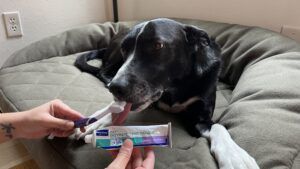
According to Mauncy, enzymatic toothpastes are helpful for dog oral health, as they are formulated with specific ingredients that target harmful bacteria in your dog’s mouth.
“The ingredients also react with sugar molecules in their mouth to create a chemical reaction that helps degrade plaque and tartar on their teeth and inhibits new tartar formation,” she says.
The Virbac option contains multiple antibacterial and plaque control ingredients (like glucose oxidase and lactoperoxidase) that help keep your dog’s teeth clean.
The Virbac C.E.T. toothpaste is one that I’ve been using on my dogs for years, and is recommended by my personal vet. My dogs are pretty sure that the poultry flavor is chicken-flavored frosting, and they usually are happy to lick the toothbrush after brushing. The beef flavor, however, has not proven to be as tasty.
This toothpaste does a great job at reducing the amount of buildup on my dog’s teeth, but I noticed anecdotally that their breath smells fresher with this one if I use it daily as opposed to just a few times per week.
Best Natural Dog Toothpaste: Vet’s Best Enzymatic Dog Toothpaste

The Vet’s Best Enzymatic Dog Toothpaste is a good option for pet parents looking for a toothpaste without artificial ingredients.
Note that not all natural toothpastes are created equally. “Natural or organic dog toothpastes may also work due to the friction from brushing to scrub the plaque off the teeth,” says Dr. Mauncy. “These should be part of a comprehensive oral routine since they do not replace dog toothpaste.”
The Vet’s Best Enzymatic toothpaste is a good middle ground option. It features an enzymatic formula to help with plaque and bad breath, but otherwise features natural ingredients, like aloe and grapefruit seed extract.
This toothpaste is banana flavored, which my dogs didn’t love, and the gel texture was runnier than other options. I felt like I had to use more toothpaste to really coat my dogs’ teeth during testing and if I wasn’t careful, the toothpaste would slide off the toothbrush before I could get it into my dog’s mouth.
Best Flavored Dog Toothpaste: Vetoquinol Enzadent Enzymatic Poultry Flavor Dog & Cat Toothpaste

Another enzymatic option, the Vetoquinol Enzadent dog and cat toothpaste, is very similar in texture to the C.E.T. toothpaste. It’s safe for both cats and dogs, is formulated with multiple ingredients that control plaque and work against harmful mouth bacteria. It also has a poultry flavor that my tester dogs absolutely loved.
It’s the only dog toothpaste on this list that includes a real meat-derived flavoring, (it has poultry extract listed in its ingredients), so it’s no surprise why the tester dogs loved it. If your dog has poultry allergies, skip this option, since it only comes in one flavor.
Cobbing in Dogs
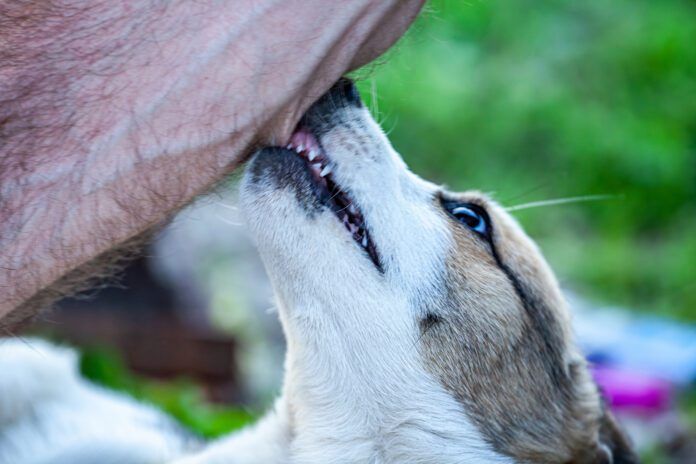
Nibbling, or “cobbing,” refers to a dog gently chewing with his front teeth. The term cobbing may have been coined because the dog’s nibbling resembles a human nibbling on a corn cob. Dogs have been known to do this to their owners, other humans, other animals, themselves, and toys. Let’s explore the many reasons for cobbing in dogs. I asked this question of both fellow trainers and just plain dog parents and received a lot of input on why dogs cob.
Why Do Dogs “Cobb”?
Expressing Affection: Many dogs seem to enjoy greeting their humans by gently nibbling on arms or hands. Dogs might nibble you when the human is scratching the exact spot on the dog’s body that gives them the most pleasure. It’s a happy relationship connection when done in these contexts. Cobbing can also often be directed at housemates when relaxing together, in what appears to be a way to affectionately reconnect. Stories from dog parent friends include tales of their dogs cobbing their best feline friend in this manner as well as their best canine friend. My puppy seems to do it to his older “sister” out of affection and when he wants to play.
Part of Play: Dogs frequently nibble each other as part of play. My giant breed puppy gently nibbles up and down the side of my Chow’s body to invite play. It’s amusing to watch. There are often some grunting and snuffling sounds that are included in this activity as well as wide grins with lolling tongues between cobbs.
Communication: Some dogs use cobbing to calm a canine housemate when they seem to be annoyed. It’s usually well received and works quickly and easily. Cobbing in this context is often focused on the side of the face and quite brief.
Grooming: Cobbing is often part of grooming other animal housemates in the home. This can be separate from simple affection shown or included with such, but grooming is the added feature here.
Teething: Puppies do this when they are teething to relieve dental pain. As the puppy finds it soothing in this context, I think the emotions from the soothing remain even after teething pain is gone, so the older puppy or dog continues cobbing.
When Dogs Cobbing May Be a Problem
Cobbing may be seen in other contexts that can be concerning.
Boredom: Insufficient enrichment, either mental or physical, can cause excess cobbing. It may be directed at humans in the home, other animals, or even inanimate objects such as pillows, blankets, toys, furniture, and other items that really weren’t intended for cobbing at all. This results in unhappy humans as well as unhappy dogs. If excess cobbing is causing destruction, assess the dog’s daily life. Is the dog getting sufficient physical exercise? Walks are not meant for cardio activity; they are mental enrichment. Make sure that your dog is getting a physical outlet for their level of activity needs, such as playing ball, playing with other dogs who are friends, or running loose in a safe enclosure.
Are they getting sufficient mental enrichment? This can include training games, being permitted to sniff to their heart’s content on walks, playing with you, and being given an opportunity to exercise their brain. Do they have concerns about a change in the routine? Change can cause anxiety, and the result can be cause for concern.
Anxiety and/or Stress: Cobbing on toys is normal until it isn’t. What I mean by that is if it’s seemingly self-soothing and not obsessive, it’s probably fine. If it starts happening suddenly when it isn’t already part of perhaps an evening self-soothing routine, then it’s time to examine what has changed to cause it. If it’s already part of how your dog winds down, but the intensity ramps up, look at the big picture. My puppy’s sudden ramped-up cobbing happened when he went on behavioral medication for anxiety. The dose was low for his weight, but it was too high for him. Reducing the dosage helped him go back to normal evening self-soothing cobbing that he can easily leave if something else catches his attention such as a chew bone.
Pain/Illness: Anxiety over not feeling well can accelerate cobbing. Making sure that you fully understand your dog’s normal behavioral responses is crucial to recognizing what is outside of normal. Because they cannot tell us what’s wrong, we must understand theirs to properly care for them.
Breed-Specific Cobbing
I used to rescue Dobermans. They are well known for self-soothing with pillows and/or blankets. I always made sure that mine had what we called “sucky pillows.” I have seen my dog-parent friends with other potentially higher-strung working breeds such as German Shepherds and various Belgian breeds as well as herding breeds like Border Collies also mention the strong propensity for cobbing. My puppy is a livestock-guardian breed and some of them can certainly be more prone to drama than say a Labrador or Golden Retriever. Again, this comes down to knowing your dog. Look at the whole picture to determine whether cobbing is a problem or not. Most of the time, it isn’t. I offer my puppy his favorite cobbing toys at night, and he grins at me. It’s all good.


